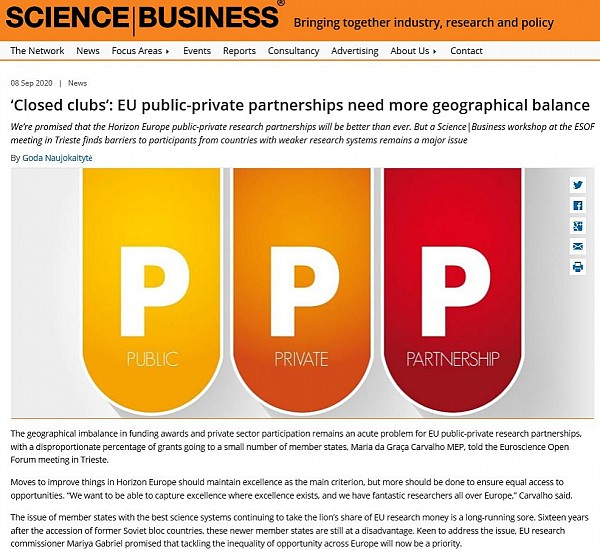Press ‘Closed clubs’: EU public-private partnerships need more geographical balance
We’re promised that the Horizon Europe public-private research partnerships will be better than ever. But a Science|Business workshop at the ESOF meeting in Trieste finds barriers to participants from countries with weaker research systems remains a major issue
By Goda Naujokaitytė
The geographical imbalance in funding awards and private sector participation remains an acute problem for EU public-private research partnerships, with a disproportionate percentage of grants going to a small number of member states, Maria da Graça Carvalho MEP, told the Euroscience Open Forum meeting in Trieste.
Moves to improve things in Horizon Europe should maintain excellence as the main criterion, but more should be done to ensure equal access to opportunities. “We want to be able to capture excellence where excellence exists, and we have fantastic researchers all over Europe,” Carvalho said.
The issue of member states with the best science systems continuing to take the lion’s share of EU research money is a long-running sore. Sixteen years after the accession of former Soviet bloc countries, these newer member states are still at a disadvantage. Keen to address the issue, EU research commissioner Mariya Gabriel promised that tackling the inequality of opportunity across Europe will now be a priority.
With the next EU research programme, Horizon Europe, starting in 2021, looking for ways to promote geographical equality without compromising excellence is again in the spotlight.
Carvalho said geographical imbalance was seen across Horizon 2020, with the programme as a whole “suffer[ing] from the same” problem. But she said, this was to a “less extent” than seen in industry-directed public-private partnerships.
There is not much partnerships can do to address the imbalance, said Magda Chlebus, chief of science policy at the European Federation of Pharmaceutical Industries and Associations, which runs the biggest public-private partnership, the Innovative Medicines Initiative (IMI) on behalf of pharmaceutical companies. In the case of IMI, most calls invite proposals for transnational research and as a result attract participants who know and have already worked with other partners around Europe. “That is why it is so important to continue investing in the ecosystems beyond partnerships,” Chlebus said.
Nicolas Brahy, director of the industry association Hydrogen Europe, agreed, this is first and foremost a Horizon Europe issue, not only a partnership issue.
Other partnership problems
Panellists flagged up a series of other shortcomings of the EU’s public-private research partnerships, ranging from late payments by the private sector, money going to non-priority research - and the inevitable bugbear of too much bureaucracy.
Most problems with the public-private partnerships arise from the European Commission and industry failing to meet halfway, according to Chlebus. “Two worlds are meeting,” she said. The multiannual planning required by the commission results in a lot of paperwork. “The bureaucracy today is still disproportionate.” While the commission wants to set out plans for years in advance, industry is much more flexible in how it spends its money, Chlebus said.
Mihails Kozlovs, a member of the European Court of Auditors, the body that scrutinises the EU’s financial management, said innovation is needed in governance, as much as in any other aspect of public-private partnerships to ensure they work efficiently. “We want to marry the public and private sectors, and the way [this marriage] is managed is not simple,” he said.
Despite shortcomings, the money is not being wasted, according to Kozlovs. European-level research is necessary to ensure global competitiveness. “Research in every individual member state - with all due respect to European research - would not manage to compete with US, China and so,” he said.
Speaking from his experience as a former civil servant Brahy agreed. The market knowledge of the private sector is invaluable. “Public servants don’t know where to put money,” he said. Companies have a much better understanding of what research and innovation is needed to boost European competitiveness.
